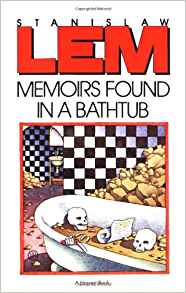 translated by Christine Rose
translated by Christine Rose
originally published in Poland: 1961
my edition: Seabury Press, 1973
188 pages
In all of this, whether trusting and believing, if only for a moment, in the Mission and my instructions, or having my hopes dashed, even the hope of my own destruction–in all of this, I had been seeking some reason, good or bad, for my presence here. But neither indications of favor nor suspicions of treachery had seemed to make the least bit of difference. Again and again I was given to understand that nothing, really, was expected of me. And that was the only thing I couldn’t accept, because it didn’t make sense. (109)
In a recent piece called “Stanisław Lem: Did the Holocaust Shape His Sci-Fi World?” we’re invited to read Lem’s sardonic, hilarious, and devastating texts in terms of the horror and brutality that he witnessed as a young man during World War II: “In Zagłada i Gwiazdy (Holocaust and Stars 2016) Lem scholar Agnieszka Gajewska argues that beneath Lem’s splendid, bold and often grotesque visions of the future, the writer buried traces of his own traumatic past – a series of terrifying experiences, which included having escaped death in a pogrom and having lost most of his relatives in the Holocaust.”
Reading a book like Memoirs Found in a Bathtub after reading that article changes nothing and changes everything. Without knowing anything about Lem’s life, one might read this novel simply as an example of the absurd, a black comedy about human existence and humans themselves as rats in a maze that has no point or meaning. Knowing about Lem’s experiences trying to survive while being hunted by people intent on killing everyone like him, though, adds an entirely new dimension to such a reading. The random and senseless violence that the narrator witnesses in the corridors, the lies, the endless bureaucracy, the suicides, the fear: Lem and his family lived this. Memoirs was born from experience, and the fact that the narrator has conversations and run-ins that are ridiculous and even humorous only underscores the tragic and terrifying nature of the story.
The quote that opens this review is one of several moments in which Lem distills this message for us. The “Building” in which the narrator is trapped is really the Earth; the “Mission” and “instructions” that he seeks are really the meaning of life. How can it be, he wonders, that no one will give him the instructions to Life, and that everything seems meaningless? But as if this realization isn’t bad enough, the narrator suffers yet another psychological blow: “I had considered myself the center of the universe, the bull’s-eye, so to speak, for all the slings and arrows the Building had to offer–and all along I was nothing, just one of a series, another copy, a stereotype, trembling in all the places my predecessors trembled, repeating like a record player exactly the same words, feelings, thoughts” (124). A profound feeling of purposelessness that isn’t even unique- that’s a hard one to swallow.
And yet, even this novel of despairing hysteria has its whimsical moments: namely, the “Introduction,” written by a historian (?) living sometime in the 32nd century. This narrator offers us a glimpse into his past/our “future”, when an alien microbe attacks all forms of paper, reducing them to dust. To Lem and everyone else writing before the Digital Age (and even now, admit it), a world without paper was a world thrown back into prehistoric times. According to the “Introduction,” civilization collapsed and centuries passed before humanity was able to scrape together information about itself and its history in an effort to understand what the planet was like pre-collapse. And while almost every scrap of paper had been destroyed, one set of papers, preserved deep underground around the time of the collapse, is excavated by 32nd-century archaeologists, who try to piece together its many strange references and events. That set of papers? Memoirs Found in a Bathtub.
A story with a nameless narrator, presented as a fragment from a centuries-old dead civilization- it’s as if Lem is throwing up wall after wall between the reader and the story; that is, between the reader and a tale of meaningless violence and confusion. How else to confront the horrors of what humans can do and have done to one another?
